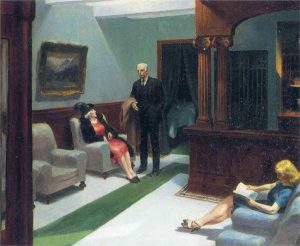As I’m not here to critique or comment on my super personal views on this story, I wanted to try and discuss what works in this story and what ultimately doesn’t. I wanted to find a reason for this method of storytelling, as it is quite different than what we’ve read so far. Something initially noticeable is the narrator’s use of second person in the first few paragraphs. “Try it. One day it will save your ass. Because unwise responses are tempting at times” (53). As you start to read, you think it’ll be first person narration, which it is until this moment. The narrator is speaking directly to us, the audience. How do we know? The key feature here is there are no quotation marks to showcase that this is spoken dialogue (as the story mostly contains). This is our narrator speaking either in his head or writing it down to share with others.
As I previously stated, this story contains quite a lot of dialogue between only two characters. While I’m a firm believer that overwhelming amounts of dialogue can slow the story, the right amount can progress it. This doesn’t seem to be the case in this story, but I also don’t think progression is the true meaning here. This story is about our narrator teaching us how to construct the perfect interview via his “three second method.” On the very first page he states: “My answers were brief and concise. My control was good. I said nothing I shouldn’t have said. I used an old trick someone taught me long ago, which was to count to three in my head before replying to a question.” The purpose of this story is to prove that this method does indeed work and it provides us with a positive example for proof. If this story wasn’t mostly composed of dialogue, we wouldn’t be able to see how this interview goes right or wrong, we’d just have to take the narrator’s word for it.
us how to construct the perfect interview via his “three second method.” On the very first page he states: “My answers were brief and concise. My control was good. I said nothing I shouldn’t have said. I used an old trick someone taught me long ago, which was to count to three in my head before replying to a question.” The purpose of this story is to prove that this method does indeed work and it provides us with a positive example for proof. If this story wasn’t mostly composed of dialogue, we wouldn’t be able to see how this interview goes right or wrong, we’d just have to take the narrator’s word for it.
In the end, we can see that Slaughter is satisfied with Jackson’s responses. Jackson says he walked out feeling good; he had said nothing he didn’t want to say. What does this say about art? Show what you have to to get your point across, it might not make sense any other way. Take risks by branching out and trying new methods. Everything came full circle in the end of this story, and while the pacing might’ve not been ideal, it still feels like a complete story.
I like the way that you took the approach of thinking about what does and doesn’t work within this story. You allowed it to challenge your views and make you see things from a different perspective!
I hadn’t thought of the story as a way for the narrator to talk about how to conduct the perfect interview, but I find it to be interesting. I do think that the use of dialogue helps the story progress in a way that keeps the reader guessing as well, which definitely kept me engaged.